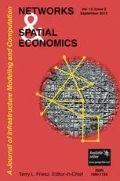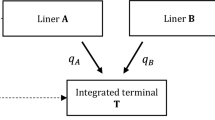Abstract
The paper discusses the theoretical and empirical evidence on the subject and concludes that freight mode choice can be best understood as the outcome of interactions between shippers and carriers, and that mode choice depends to a large extent on the shipment size that results from shipper-carrier interactions. These conclusions are supported by economic experiments designed to test the hypothesis of cooperative behavior. This was accomplished by conducting two sets of experiments (ones with the shipper playing the lead role in selecting the shipment size; and others in which the shipment size decision was left to the carriers), and by comparing their results to the ones obtained numerically under the assumption of perfect cooperation. The comparison of results indicated that the experiments converged to the perfect cooperation case. This is in line with the conclusion from game theory that indicates that under typical market conditions the shipper and carrier would cooperate. These results also imply that it really does not matter who “makes” the decision about the shipment size and mode to be used at a given time period, as over time the shipper—that is the customer—ends up selecting the bids more consistent with its own interest. In other words, these results do not support the assumption that freight mode choice is solely made by the carriers.








Similar content being viewed by others
References
Abdelwahab WM (1998) Elasticities of Mode Choice Probabilities and Market Elasticities of Demand: Evidence from a Simultaneous Mode Choice/Shipment Size Freight Transport Models. Transp Res Part E Logist Trans Rev 34(4):257–266. doi:10.1016/S1366-5545(98)00014-3
Abdelwahab WM, Sargious MA (1991) A Simultaneous Decision-Making Approach to Model the Demand for Freight Transportation. Can J Civ Eng 18(3):515–520
Abdelwahab WM, Sargious MA (1992) Modelling the Demand for Freight Transport. Can J Civ Eng 26(1):49–70
Abdelwahab WM, Sayed T (1999) Freight Mode Choice Models Using Artificial Neural Networks. Civ Eng Environ Syst 16:267–286. doi:10.1080/02630259908970267
Arunotayanun K, Polak J (2007a) Taste heterogeneity in freight shippers' mode choice behaviour. Annual Meeting of the Transportation Research Board, Washington, DC, Transportation Research Board
Arunotayanun K, Polak J (2007b) Unobserved heterogeneity in freight shippers' mode choice behaviour. World Conference on Transport Research, Berkeley, CA
Catalani M (2001) A Model of Shipper Behaviour Choice in a Domestic Freight Transport System. 9th World Conference on Transport Research, Seoul
Chiang Y, Roberts PO, Akiva MB (1980) Development of a Policy Sensitive Model for Forecasting Freight Demand. Massachusetts, Center for Transportation Studies, Cambridge
Davis D, Holt C (1993) Experimental economics. Princeton University Press, Princeton New Jersey
De Jong G (2005) Experimental economics, transport and logistics. European Transport Conference, Strasbourg, France
De Jong G (2007) A model of mode and shipment size choice on the Swedish commodity flow survey. Universities' Transport Study Group, Leeds
Friedman D, Sunder S (1994) Experimental methods. Cambridge University Press, Cambridge, Massachusetts, A Primer for Economists
Golias J, Yannis G (1998) Determinants of combined transport's market share. Transport Logistics 1(4):251–264. doi:10.1163/156857098300155250
Hall R (1985) Dependence between Shipment Size and Mode in Freight Transportation. Transp Sci 19(4):436–444. doi:10.1287/trsc.19.4.436
Holguín-Veras J (2002) Revealed Preference Analysis of the Commercial Vehicle Choice Process. J Transp Eng 128(4):336–346. doi:10.1061/(ASCE)0733-947X(2002)128:4(336)
Holguín-Veras J (2008) Necessary Conditions for Off-Hour Deliveries and the Effectiveness of Urban Freight Road Pricing and Alternative Financial Policies. Transp Res Part A policy Pract 42A(2):392–413. doi:10.1016/j.tra.2007.10.008
Holguín-Veras J, Silas M, Polimeni J, Cruz B (2007) An Investigation on the Effectiveness of Joint Receiver-Carrier Policies to Increase Truck Traffic in the Off-Peak Hours. Part I: The Behavior of Receivers. NETS 7(3):277–295. doi:10.1007/s11067-006-9002-7
Holguín-Veras J, Silas M, Polimeni J, Cruz B (2008) An Investigation on the Effectiveness of Joint Receiver-Carrier Policies to Increase Truck Traffic in the Off-Peak Hours. Part II: The Behavior of Carriers. NETS 8:327–354. doi:10.1007/s11067-006-9011-6
Holguín-Veras J, Thorson E, Ozbay K (2004) Preliminary Results of an Experimental Economics Application to Urban Goods Modeling Research. Transp Res Rec 1873:9–16. doi:10.3141/1873-02
Isacsson G, Nilsson J-E (2003) An experimental comparison of allocation mechanisms in the railway industry. J Transp Econ Policy 37(3):353–382
Jiang F, Johnson P, Calzada C (1999) Freight Demand Characteristics and Mode Choice: An Analysis of the Results of Modeling with Disaggregate Revealed Preference Data. J Transp Stat 2(2):149–158
Kim K-S (2002) Inherent Random Heterogeneity Logit Model for Stated Preference Freight Mode Choice. J Korean Stud 20(3):1–10
Lunander A, Nilsson J-E (2004) Experimental Tests of Alternative Mechanisms to Procure Multiple Contracts. J Korean Stud 25(1):39–58. doi:10.1023/B:REGE.0000008654.68169.08
McFadden D, Winston C, Boersch-Supan A (1986) Joint Estimation of Freight Transportation Decisions under Non-Random Sampling. Analytical Studies in Transport Economics. A. Daugherty, Cambridge University Press: 137–157
McGinnis MA, Corsi TM, Roberts MJ (1981) A Multiple Criteria Analysis of Modal Choice. J Bus Logist 2(2):48–68
Nam KC (1997) A study on the estimation and aggregation of disaggregate models of mode choice for freight transport. Transp Res Part E Logist Trans Rev 33(3):223–231. doi:10.1016/S1366-5545(97)00011-2
Norojono O, Young W (2003) A stated preference freight mode choice model. Transp Plan Technol 26:2
Samuelson RD (1977) Modeling the freight rate structure. Center for Transportation Studies, Massachusetts Institute of Technology, Cambridge MA
Train K, Wilson W (2006) Spatial Demand Decisions in the Pacific Northwest: Mode Choices and Market Areas. Transportation Research Record, in press
Wilson FR, Bisson BG, Kobia KB (1986) Factors that determine mode choice in the transportation of general freight. Transp Res Rec 1061:26–31
Acknowledgements
The research reported in this paper was supported by the National Science Foundation’s grants CMS-0324380. This support is both acknowledged and appreciated. The authors want to recognize the input provided by anonymous reviewers that helped improve the paper.
Author information
Authors and Affiliations
Corresponding author
Rights and permissions
About this article
Cite this article
Holguín-Veras, J., Xu, N., de Jong, G. et al. An Experimental Economics Investigation of Shipper-carrier Interactions in the Choice of Mode and Shipment Size in Freight Transport. Netw Spat Econ 11, 509–532 (2011). https://doi.org/10.1007/s11067-009-9107-x
Published:
Issue Date:
DOI: https://doi.org/10.1007/s11067-009-9107-x




